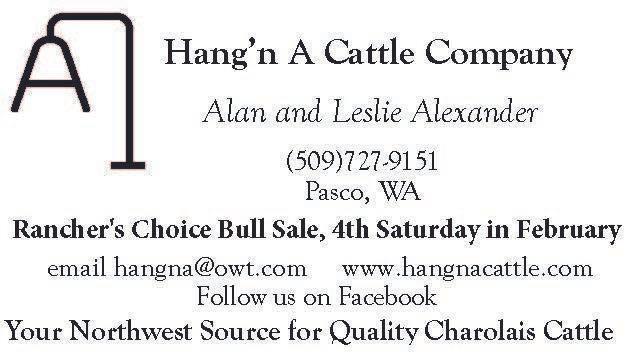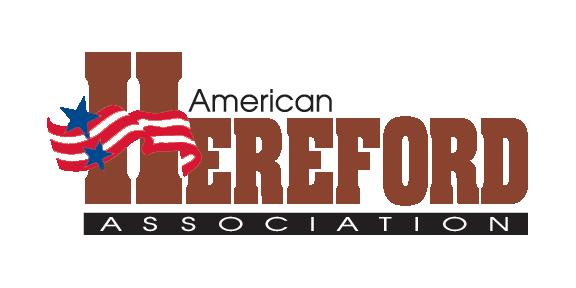




























PRESIDENT Mark Pratt..................(Blackfoot) 208-681-6597
PRESIDENT-ELECT
Kim Brackett (Homedale) 208-308-1952
VICE PRESIDENT
Jerry Wroten (Wilder) (208) 831-7339
PAST PRESIDENT
Jay Smith ...........(Carmen) 208-940-1020
TREASURER
Cody Hendrix (Rigby) 208-360-9693
FEEDER COUNCIL CHAIR
Spencer Black (Almo) 208-647-8130
PUREBRED COUNCIL CHAIR
Val Carter (Pingree) 208-390-4811
COW-CALF COUNCIL CHAIR
Brayden Eliason (Holbrook) 208-705-2541
CATTLEWOMEN COUNCIL CHAIR
Maggie Malson (Parma) 208-739-2265
DISTRICT 1 REPRESENTATIVES
Mike McClean.............(Post Falls) 208-661-7518
Quin Wemhoff (Kamiah) 208-983-6448
DISTRICT 2 REPRESENTATIVES
Lori Ireland (Mountain Home) 208-866-0112
Marg Chipman (Weiser) 208-550-0605
DISTRICT 3 REPRESENTATIVES
Eugene Matthews (Oakley) 208-431-3260
John Peters (Filer) 208-358-3850
DISTRICT 4 REPRESENTATIVES
Ryan Steele (Idaho Falls) 208-390-5765
Norman Wallis (May) 208-993-1342
DISTRICT 5 REPRESENTATIVES
Roscoe Lake (Blackfoot) 208-604-3650
Arnold Callison (Blackfoot) 208-681-8440
ALLIED INDUSTRY REPRESENTATIVE
Kelton Hatch (Kimberly) 208-539-0417
DIRECTORS AT LARGE
Robert Oxarango (Emmett) 208-431-0777
Adrian Meyer (Grand View) 208-509-1892
CATTLEWOMEN BOARD REPRESENTATIVE
Tay Brackett (Filer) 208-866-4967



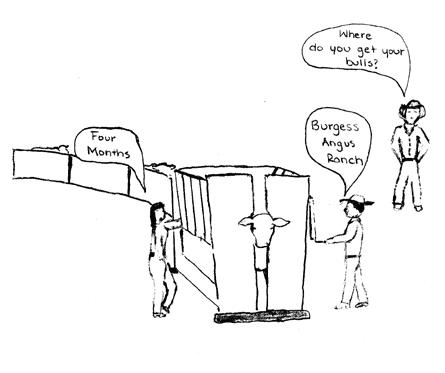
What a time to be in the cattle business. Ok, maybe not right this minute with margins pinched to the bear minimum. I’m reminded of what my cousin Kent says, “I hope I break even, I could sure use the money.” But we in agriculture always have a strong hope that next year will be better. Acknowledging that we’re “next year” people, it’s encouraging to hear the forecast of better prices ahead.
Along with a better market, we keep hear ing about all the money becoming available for water projects and climate smart practices. Get your ducks in a row so you can take advantage of this opportunity.
I received an email the other day from ICA Past President Jay Smith. He said, “Please take a few minutes and check this out, then let me know how we can make a plan to spread it far and wide.” I was surprised and excited to see the link was to Allan Savory’s 2013 TED talk. Check it out for yourself. Allan has spent his life as a stu dent of the natural world and understands that well managed grazing is our best hope to restore degraded ecosystems around the world. In a re cent Facebook post, Savory said the talk is being viewed 3,000-4,000 times per day. Another You Tube video worth watching is Christine Jones’s soil health presentation she gave in Idaho Falls a couple of years ago. Soil health and good grazing practices go hand in hand, and we should all take
BY MARK PRATT ICA Presidentsome time this winter and learn how our ranches can play a vital role towards a sustainable future.

Wouldn’t it be nice to be paid for the ecosystem services you provide? Water storage, wildlife habi tat, carbon capture, biodiversity, are attributes the public depends on. Can we agree that overgrazing is a factor of too much time rather than too many animals? There are a growing number of grazing operations positioning themselves to take advan tage of an ecosystem service market by shortening their graze period, lengthening their rest period and monitoring their results.
Conservation is defined as the prevention of the wasteful use of a resource. When applied to ecology it is defined as the preservation, protection, or res toration of the natural environment and of wildlife. Our own Public Lands Council has been working diligently in Washington, D.C. to have grazing in cluded in the 30x30 plan as a conservation practice.
And as exciting as all of this is, it’s only one of the many facets of ranching from financial figur ing and supplement strategies, to working with state and federal agencies and our own family members in constructive ways that run through my mind as I go about my days (and nights).
I copied a Peanuts cartoon many years ago that amused me at the time and still rings true:
We have not succeeded in answering all of our problems. Indeed, we often feel we have not completely answered any of them. The answers we have found only serve to raise a whole set of new questions. In some ways we feel we are as confused as ever, but we believe we are confused on a much higher level, and about more important things.
This pretty much sums up my year as pres ident and our lives here on the ranch. Thanks for the journey.
MESSAGE FROM THE PRESIDENT
Although many questions remain, the mission stays the same.
Conservation is defined as ‘the prevention of the wasteful use of a resource.’


640± acres with meadows, forests, a creek, & abundant wildlife. $5,350,000 Also offered as two 320± acre parcels. $2,970,000 each.
SOLD
690± acre ranch features 285± irrigated acres, 2 wells, ponds, springs, and BLM frontage. The manager’s home and 6 rental units rent for $72,000 per year. 25± miles from Sun Valley. $5,000,000


953± acres in near Orofino with 623± acres of dry farmland, timber and canyon lands, possible home site development, and great hunting, fishing and outdoor recreating. Sold $4,284,000

436± acres with 250± acres irrigated by 5 pivots and 3 wheel lines. Includes a manufactured home. Zoned for 1 home/acre, and 1 home /10 acres. 30± air miles from Sun Valley. $3,500,000 SOLD
120± acres with a creek and two springs. The Barndominium home has 3,603± sf of living space. Under construction with materials to complete the interior included. Near Potlatch, ID. $2,999,000


947± deeded acres and an additional 160± acres of BLM leased land. Great grazing ground bordering National Forest with two year-round springs, and excellent hunting. $2,249,000


CABARTON CASCADE RANCH
202± acre ranch features a 5 bedroom home with geothermal heat, and shop. Fenced and irrigated. In Valley County with road frontage and development potential. SOLD $3,500,000
Iam sure as you read this, you thought of every time your parent or grandparent spoke that phrase. It is just as true today as the first time it was ringing across your ear drums.
As we look at our industry and the changes across our state, I continue to look and think, “We can’t help those that won’t help themselves”. The population is changing and becoming more and more distanced from the land, agriculture, and from the very things that maintain life.
Our industry itself is not always immune from this. From time to time, opportunities are presented in our local communities, statewide events, and even at times national level, where pro ducers have the opportu nity to tell our story in a way that is beneficial to our own operation, as well as our entire industry. We need to continue to tell our stories and create oppor tunities to help ourselves! The media continues to cast shade on our indus try through the climate change discussion. Our association has been work ing with our partners to send the message of the benefits of cattle grazing on both soil health and our environment. Public perception then be comes reality when there is no attention given to the other side of the issue.
I have been told since I was young, and again from time to time as I have gown older, “If you do some thing good, you don’t have to tell people- they will see it.” I believe this to still be true, but the problem lies in the fact that no one is looking. We are going to have to
BY CAMERON MULRONY ICA Executive Vice President
shamelessly brag on ourselves, our industry, and our successes or no one will notice.
Idaho Cattle Association’s longtime partner, the Idaho Range Land Resources Commission (IRRC), re cently completed a statewide survey on acceptable uses of rangelands. When it came to our industry, the num ber of respondents who marked “Don’t Know” contin ues to increase. Our new neighbors who have moved to our rural and ranching communities, either from out of state or elsewhere in Idaho, are not necessarily com ing with preconceived notions of our industry. Howev er, as they arrive, it becomes our duty to inform them about the benefits of our industry how we as cattlemen, are good neighbors and stewards of the land. We are standing at the trough each time we meet a recently landed Idahoan, and if we handle it correctly and drink a bit (tell our story), we are helping ourselves and our industry. We can quickly change an “unknown” to an ally if we will take this opportunity to help ourselves.
Again, perception becomes reality- if you can not see the good, or at times have it pointed out to you, the change in perception may become err to the negative, even in your own back yard.
When you are led to the water, take a drink! And by drink, I mean introduce yourselves, tell your story, talk about all the positives you (and your operation) bring to local society. Paint the reality of the benefits that Idaho’s cattle industry provides to our neighbors. By helping yourself, you in turn help everyone in the beef industry. Don’t let the perceptions smear the painting of reality. Whether it be an industry development or exciting expansion, we need to tell our partners in the industry and boast to the public at large, as it relates to the benefits we provide our state and citizens.
If the life of a cattleman or cattlewoman was easy, everyone would do it. It’s the hard work and determi nation of all involved in our industry that keeps it alive and thriving each and every day.

“You can lead a horse to water, but you can’t make him drink!”


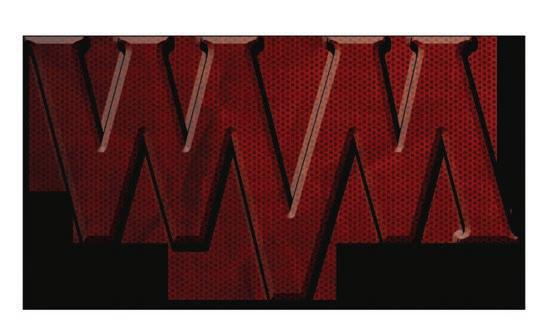





Our Annual Convention is just days away and I hope you have made plans to attend.
Like Thanksgiving, ICA’s Convention is a much-anticipated event that comes around ev ery November and is focused on the benefits of gathering together. As grandma may say about the prospect of family coming to her dining table once a year, “the more, the merrier”. Just like at the Thanksgiving table, our association benefits from lively discussion and interaction amongst cattle producers with varying backgrounds and
opinions. I, for one, am looking forward to the reunion-style feel of meeting up with cattlemen and women from around the state and hearing about current industry issues. In addition to hear ing engaging conversation and interesting meeting presenters, we will also spend time updating our policy book. The resolutions process is one of the main purposes of holding a convention. We gather so our membership, the cattle producers of Idaho,
BY KAREN WILLIAMS ICA Natural Resources Policy Director
have an opportunity to review our existing policies and to present new ideas and new direction for ICA to undertake. Our resolutions determine our prior ities for the coming year and provide staff and lead ership with direction on how to address, improve, or fix issues facing Idaho’s cattle industry.
At our policy meetings at convention, not only do we provide the opportunity to question and review existing policy, we also consider newly proposed resolutions, amendments to resolu tions, and sunsetting resolutions. So, what are the issues that we’ll be discussing this year? We have two new proposed resolutions, developed through the ICA committee process for your con sideration. These two policies are in response to two very current and hot topics that ICA staff and leadership have found ourselves addressing with increasing prevalence as we represent Idaho’s cattle industry. These resolutions are included below so you can be prepared to come to conven tion and make your voice heard on these issues:
WHEREAS: As Idaho’s population expands, de mand for outdoor recreational opportunities expo nentially increases; and
WHEREAS: The increase in recreation has disrupted land management on public and pri vate lands, has adversely affected ranching op erations, and has created many challenges which are further compounded by a lack of enforcement and education.
THEREFORE, BE IT RESOLVED: That the Ida ho Cattle Association asks state elected officials and
agency leadership to acknowledge the impacts of increased outdoor recreational pressure and create a task force to enact more meaningful, focused management of recreation.
BE IT FURTHER RESOLVED: That the Idaho Cattle Asso ciation works collaboratively with other land users and recre ational groups to develop solutions to the challenges present ed by increased and unenforced recreation.



WHEREAS: Renewable energy project development has been incentivized by the federal government creating an influx of development proposals on Idaho’s state and federal lands.


WHEREAS: The renewable energy projects and associ ated infrastructure development displace livestock grazing in the short term and have the potential for long term con sequences limiting grazing on the land on which the devel opment occurs.
THEREFORE, BE IT RESOLVED: That the Idaho Cattle Association actively participates in the public processes re garding energy development to assert our priorities regarding multiple use, the economic and conservation value of contin ued livestock grazing, and no net loss of grazing AUMs.



BE IT FURTHER RESOLVED: That the Idaho Cattle As sociation defer to the locally impacted permittees/lessees and local members to inform our position and approach on site specific proposals.
Do you have any thoughts on these, or other, cattle indus try issues? Please come to convention and participate in our resolutions discussions which will occur during the council sessions on Monday, November 14 at 3:30 pm and the Policy Session on Tuesday, November 15 at 10:30 am. In addition to the above proposals, members will vote on whether to renew or sunset several more resolutions that are up for their annual 5-year review. Our resolutions serve as cornerstones for ICA as we have to react and respond to current events affecting our industry. The need for our association to have member-driv en, member-approved policy is underscored by the mounting pressures Idaho’s cattle industry faces. If you have questioned our action on any issue, we invite you to come share your thoughts during the resolutions session. Or, if you know of a new issue that you think ICA needs to address, it is not too late to propose policy at convention—though it will need to be brought to the floor by the approval of a 2/3 majority vote. All resolutions will be finalized during the Annual Membership Meeting on the afternoon of November 15 at 3:45 pm. I look forward to seeing you there and hearing your input as we set policy and chart our course for the coming year. You have an important role to play in our association!

One of my favorite parts of the Purebred business is having the opportunity to visit with cattle pro ducers around the state. These operations vary in size from a dozen pasture cows to corporate ranches with several thousand mother cows. Most calve in the spring, some calve in the fall, and some calve all year round . Some producers run a straight bred herd while others cross breed and some patronize every breed. Ev ery ranch is different in terms of their size, location and resources. They vary in available capital, labor, feed and grass. They are all vital to our industry and represent one sector of agriculture, the backbone of our rural commu nities. I love the good hard working people of agriculture who care for the land, look after their neighbors and feed a world that often criticizes their efforts and has a lack of apprecia tion for all they do.
I have spent my entire life farming and ranching. With the exception of a couple of harvest jobs shortly after high school graduation, I’ve never worked for anyone but my banker. My wife and I and our family have relied on livestock as our main



 BY VAL CARTER Purebred Council Chair
BY VAL CARTER Purebred Council Chair
source of income since our marriage 38 years ago, shortly after my one semester of college. So as a dis claimer on any forthcoming advice, just know that this is coming from an under educated “wannabe cowboy” who gained most of his wisdom and experi ence from making lots of mistakes. Now the advice. As I reflect back on my time spent farming and ranching, if I could do it over again, I would have spent more time early on developing a vision of what I wanted to become and accomplish in the cattle industry and life, and make a concerted effort to prioritize those things and “begin with the end in mind.”
Unfortunately most of us have a banker so being profitable is of necessity usually near the top of our priority list; however, there are other decisions equal ly as important. The manner and integrity with which you conduct business is vital to your long term success. If you are always honest and fair with the people you do business with, you will gain a reputation of trust in those relationships and people will want to do business with you. If you purchase for less than fair value or misrepresent what you sell to get more than its value, you will have a short term gain but will lose much more over the course of time. I am probably preaching to the choir here, because in 30 years of selling Angus bulls we have never not been paid for a bull. I truly believe that many business opportunities are gained or lost simply because of the reputation you have created for yourself. As you come to see the vendors who provide you a service, and the customers who buy your prod ucts, as partners with whom you could not do without, you will come to appreciate them more and under stand they are essential to your success. This is espe cially true of employees. If they are rewarded fairly for their contributions and treated with appreciation and





respect, they will rise to your expectations and can become trusted friends.

For our family, the way of life and cul ture of ranching has been a high priority. Wealth and fortune will never replace the value of an environment where kids learn responsibility, work ethic, honor and in tegrity. When kids understand their con tribution is vital to the family and ranch sustainability, they feel valued and needed more than a “make work” situation created for them. Sometimes the ranch work isn’t always done in the fastest most efficient manner, but it gets done and they develop a confidence and endearing memories of work and play. I can’t tell you how many times, as we’ve been getting grandkids mounted to gather cows, I’ve thought to myself, this isn’t easy country and it’s go ing to be a long day, these kids should not be going. Then the grand kid who began the day being led on a horse by a parent, gained their confidence and like sprout ing wings was gleefully trotting all over the mountain on their own by the end of the day. I then remember how quickly our kids went from slowing us down to being essential to accomplishing the day’s work. Combined with faith, family and tradi tion, they come to know who they are and develop an identity that helps keep them grounded and close their entire life.



The culture surrounding ranching is unique. In many communities, branding time is an opportunity to trade work and gather as family, friends and neighbors to accomplish a vital task. It also provides an opportunity to visit, hone roping skills and merge work and recreation for a few hours. You don’t have to be a part of the cowboy culture to have a successful cattle operation. I’ve seen some very successful ranchers that didn’t rope and ride, but for our family it has been good for bonding and we have enjoyed the horsemanship, improving cattle handling skills, and the thrill of watching a young pup turn into a skilled working dog. Sometimes it just makes the hard days go by faster when you enjoy what you are doing.
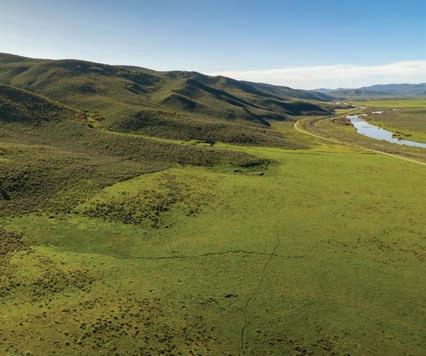








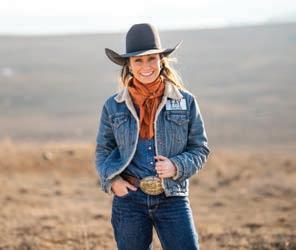




Better cattle make for a better bottom line. The mission is pretty straightforward.
“We focus on primarily producing registered Angus bulls for breeding,” said Lee Muench, “for other ranchers to use in their breeding program to improve their herds, and increase their profits by having superior Angus genetics.”

Lee and his wife, Marilee, own and operate Patriot Cattle Company on more than 400 acres just south of Grangeville. This family-owned business started in fall 2018 and has grown steadily since in serving the region’s cattle producers, with plans to expand into the Inland Northwest and beyond.
Lee and Marilee complement each other in abilities to operate a 24-7, 365-day business that also incorporates raising their three children: Weston, 7, Roy, 3, and Dor othy, 1. A local man, and raised in Grangeville, Lee comes from a cattle ranching family, while Marilee was raised in the suburbs near San Francisco — a country boy and a city girl who hit it off and made it work.

“Mom and Dad had a predom inantly commercial herd of Her eford-Angus cross cattle and a smaller number of registered An gus, as well,” Lee said. “Growing up, I was always intrigued by the purebred aspect; choosing sires from all over the country and us ing their genetics to improve our herd.”

“We met in college, as we were going through the ROTC program,” Marilee smiled. “Once Lee com pleted his obligation to the Army, I realized that I’m OK anywhere as long as I have family. I prefer small
communities like Grangeville which encourage good family values, and where we can pursue our faith freely. So, when he said, ‘I want to ranch,” I said, ‘Ok, I can do that,’ and that was that. I was game, and I’m learning constantly.”
“We balance each other out pretty well,” Marilee contin ued. “God has given him certain strengths and given me cer tain strengths, with which we complement each other well.”
Lee does most of the herd side of the operation: choosing sires to use in the breeding program, making determinations on animals that make the grade to keep and develop to sell to ranchers. Marilee does the majority of the bookkeeping, and works on the growing marketing plans that in clude advertising, social media and website development. Their website, www.patriotcattlecompany.com, recently launched and they can be found as Patriot Cattle Company on both Facebook & Instagram.
Cattle production is busy work, around the clock, whether you’re raising animals for the commercial meat market or for seed stock — “We all work really hard, we’re just in different sections of the industry,” Marilee said. One difference with their operation is the more technical aspect of breeding, and the narrow window to conduct this activity.
“We synchronize the estrus cy cles of all the cows and inseminate them at a certain time,” Lee said. “We have to put the cows through the working chute two to three times to get them synchronized, so when we breed them we expect at least a 75% settling rate the first heat. Af terwards, we turn in our clean-up bulls to cover any cows which may cycle in subsequent heats.” Com mercial producers on average have a 45- to 90-day window to get all their cows bred, “and the way we have chosen, we have to work them at very specific times,” Marilee con tinued. “We have a three- to fourhour window to get them bred us ing artificial insemination.”
One aspect of this operation Lee prefers is calving, due to the calves being born in late summer/early fall.
“It’s a lot easier at this time of year, than when you’re calving in a blizzard and trying to keep calves alive,” he said...though cows still need monitoring — notably firstcalf heifers — which means Lee doesn’t get out of his share of late nights to save a newborn.
For Patriot Cattle, the operation in large part is keep ing meticulous records on every cow, in evaluating their strengths, areas of improvement, and matching up these through the semen catalogues. Where a heifer needs im
provement in an area, she will be matched up with a bull that is strong in that trait, “and hope fully improve the genetics for the next calving season.”

Better genetics doesn’t mean the same thing for each rancher.

“Commercial ranchers have different needs based on the en vironment and the country they are on,” Lee said. For example, the Salmon River country with its steep, rocky drainages is harder and more sparse than that of the open, flat pasture of the Camas Prairie, “so those animals have to get by and gain pounds by not getting as good forage.” It’s sim ple mathematics: pounds equal dollars for the commercial ranchers, and Salmon River producers need to start with an 80-pound calf and sell it at 600 pounds in hard country where it’s more diffi cult to thrive.
“Our goal is to breed bulls for both types of ranchers that will be able to breed cows while at the same time maintaining condition and not completely falling apart,” Lee said. “Because, in turn, their calves will thrive the following year. It’s a never-ending cycle of improving ge netics of certain animals that can convert lower quality forages into pounds.”
In developing their bulls, Lee said they don’t confine them to a feedlot and force-feed extra “hot” rations in order to bulk them up so the end weight gain numbers look impressive, but rather they are developed in real conditions.

“By grazing on grass and developing slowly, their bodies learn to perform in real conditions because they were raised in real conditions,” Marilee said, with Lee adding, “Our bull calves still gain weight really well, and when they go to breed cows in the real world they won’t fall apart.... I think it’s more important that when someone buys a bull from me, what they see is what they get.”
Marilee is still on her learning journey in being a rancher’s wife, one that is helped not only by Lee, but as well from her children who work by their sides.

“I had some hesita tion. I wasn’t sure what I would be saying yes to,” she said, when Lee asked her to come on this ranching venture with him as his wife. Lee told her what a blessing it is for children to grow up in this type of lifestyle, and “now, as a mother,
and having grown up in another environment and seeing the contrast from that with what our children do on a daily basis, it really is special.”
The couple praise the area and their occupation as al lowing them to see miracles every day, to be stewards of these animals as God intended, to contribute to society in a meaningful way, and to convey those things worth knowing to their children.
“It’s the best place to raise a family; a complete family in volvement,” Lee said. “The boys work with me all the time, they grow up in an area where they get to learn — now in this day and age — oldschool values, values that founded this country,” including biblical princi ples, honesty and integ rity. “People take values such as these for granted nowadays, but we val ue them. We get to raise kids in this area; family is very important to us, and this is a great way to combine them.”
“It’s raw, real life what we feel we have here,” Marilee said, “and it’s re ally special.”
“WE KEEP A CLOSE EYE ON OUR NEWBORN CALVES IN ORDER TO REMEDY ANY ILLNESSES THEY MAY CONTRACT.”




As we continue in our Indepen dent Idaho series, we are look ing at facets of the beef industry that set us apart from other states in the nation, as well as highlighting new ad ditions to the value of being an Idaho producer. Part of this value is the avail ability of, and the access to, processing plants currently and soon to be online. One of these plants that is drawing par ticular interest in the Magic Valley, is the True West Beef plant which is part of the Agri Beef family. Jay Theiler, EVP of Corporate Affairs at Agri Beef, was able to give ICA an inside look and update on how the plant came to be, as well as what the beef community can ex pect going forward.
The True West Beef plant will be the newest beef processing facility in the United States when it opens for busi ness sometime in early 2023. While there is no “official” opening date at this time, the project was first publicly announced in July of 2020 as a part nership between Boise based Agri Beef


(Twin Falls) off Hwy 93, and within a day’s reach of most major Metro mar kets in the West.
Co. and livestock partners from around the region. The goal of the new plant is to provide more opportunity for lo cal livestock producers and to keep as many cattle as possible in the region. The plant site is strategically located in Jerome, Idaho, approximately 7 miles north of the I-84 Exit 173 interchange
Agri Beef has long standing roots in the area and began as a cattle-feeding operation itself in American Falls in 1968. Today the company is structured with operations in each step of the beef supply chain including ranching, cattle feeding, beef processing (Wash ington Beef), animal nutrition (Per formix Nutrition), and beef marketing and sales. The company was an early adopter of beef branding and market differentiation as a way to compete in a commodity dominated industry and they are now well recognized for pro ducing high quality beef under brand names like Snake River Farms Amer ican Wagyu Beef and Double R Ranch Northwest Beef.
The True West Beef plant represents a new direction in the beef business by including livestock producers as equity part ners in the beef production supply chain. The lack of process ing capacity in Idaho, as well as hurdles made evident during the COVID bottlenecks, all served as motivators in the birth of the overall project. During the process of acquiring part ners, it was important to Agri Beef that this endeavor have a mix across all sectors (eg. Cow-calf, backgrounder, feeders) in the Northwest- which was in order to ensure adequate sup ply across all seasons. Not only are these partners ‘owners’, but they are also suppliers to the new facility, and they will be vested in the overall success of True West Beef. It was also important to note that these partnerships were formed on the basis of a long-standing relationship with Agri Beef, as well as with those that have similar core values as Agri Beef. This approach has several advantages besides the obvious benefits of participating in the profit and loss of the processing plant and a diversification of risk. The owners hope this collabo rative model will also meet growing consumer expectations for knowing where their beef comes from, by authenticating a high-quality ranch-to-brand market position and providing consumer preference information back to producer partners to continually improve the overall herd genetics, cattle health, marbling capability, etc. Agri Beef is a majority partner in the venture with over 50% ownership and they will provide man aged services for the operation of the new facility.
Once the new plant is operational, the plan is to continue to build demand for the brands that the company has built over the years, as well as potentially build new brands, and to offer toll processing services to other producer groups with their own beef programs or brands. True West Beef will encompass over 200,000 sq feet and is designed to initially process 500 head per day. Once the project gets past the start-up phase, and once production number are achieved, there could be op portunities for additional expansion, but that will be up to the decision of the Partners and the overall economic conditions at that time. The plant is projected to provide over 350 jobs
when at full employment, giving a boost to the economy of Jerome County and the Magic Valley area.
The company says it has already hired most of its man agement team, with a core group of those joining True West Beef with previous beef processing experience at Agri Beef’s



Washington beef plant in Toppenish, WA. The company says it is planning a series of hiring fairs in the Magic Valley to begin hiring its pro duction workforce in the next few months, and that no previous meat-packing experience will be necessary, as True West Beef plans to invest heavily in employee education and training. When assessing the availability of packers in the state, it’s important to note that Idaho is fortunate to have an existing packer in the Boi se area, CS Beef, which is a partnership between Caviness Beef Packers & Simplot. Additionally, there are plans in motion for Intermountain Beef to come online in Fall 2022 in Idaho Falls, as well as an additional plant in that area sometime in 2023. The addition of True West Beef, as well as other facilities noted, pack a serious punch of val ue towards a producer’s ability to keep their busi ness in the state of Idaho for most, if not all, of the industry chain. Stay tuned for our finale, Part 3 of the series, where we will finish with a recap of our annual convention and tie together the details that make up the Idaho beef chain!












Beef Quality Assurance (BQA) prac tices are the wave of the future for the beef industry to maintain and expand their market. In Idaho, we recognize the importance of supporting training for BQA certification to keep and improve Idaho’s competitive edge in a market that is crowded with con sumer options.
For more than 30 years, the Nation al Cattlemen’s Beef Association (NCBA) BQA training and certification program has been guiding ranchers, veterinari ans, and transportation professionals. BQA standards outline proper cattle management techniques for the beef in
dustry. Adopting BQA practices demon strates the cattle industry’s commitment to proper cattle handling and product quality, resulting in improved profit ability and helping to raise consumer confidence in the quality and safety of their food. According to NCBA, “BQA is for cattleman who believe doing things the right way is the only way.”
Regular surveys are conducted both nationally and with populations in Ida ho to learn what consumers care about and consider in purchasing and con suming beef products. The top areas of interest for Idaho consumers are prod uct safety and proper cattle manage ment and well-being.


Industry studies have shown that cattle managed through BQA practices command a per head premium of nearly $17 (in 2019). In addition, studies of con sumer perceptions have demonstrated improved consumer confidence in the industry when they learn about the beef industry commitment to BQA standards.
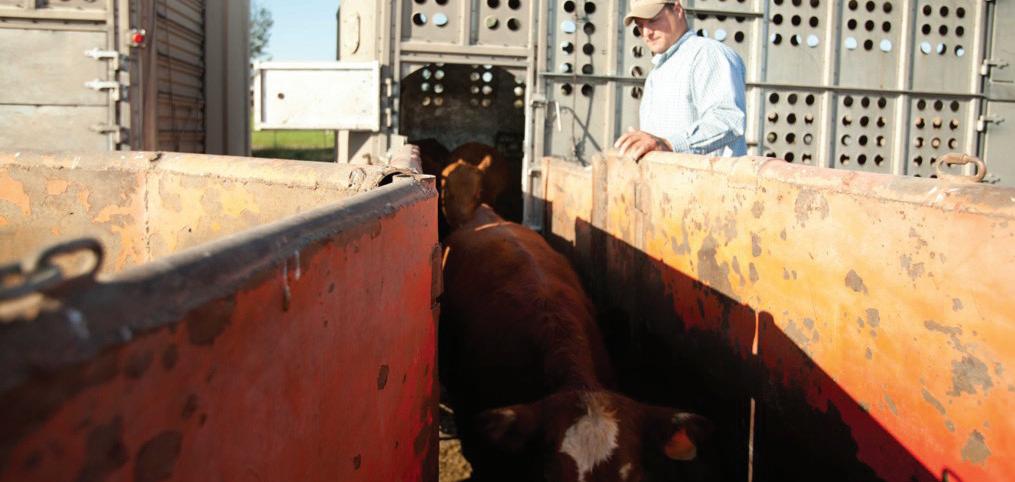
Cutting losses through BQA prac tices can also improve profitability. In 2016, it was estimated that meat quality defects cost the industry an es timated $521 million. Bruising alone
from improper handling led to a loss of $62 million. Best management practic es through BQA implementation was es timated to benefit the industry by more than $325 million.
The retail and foodservice industries have picked up on the benefits of merging consumer interests with cattle industry benefits by establishing requirements for beef product purchases from BQA-cer tified producers. In 2019, Tyson Foods and Cargill Protein required purchases through BQA-certified producers and in 2020, Tyson Foods harvest facilities required specific certification through
BQA-Transportation training. Other in dustry partners have followed suit with JBS, Cargill, Greater Omaha, and even Wendy’s establishing that beef products will be purchased from BQA-certified farms and ranches.

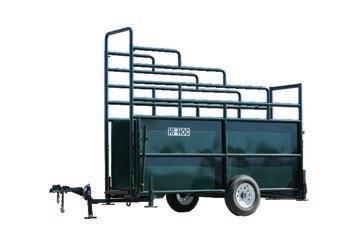
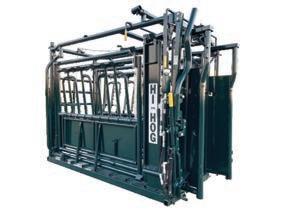
BQA Certification training can be completed online or through attending an in-person training event. Online BQA courses are available at: https://www. bqa.org/beef-quality-assurance-cer tification/online-certifications. These modules include BQA for producers and transportation. Producer courses include Cow/Calf, Stocker/Backgrounder, and Feedyard options. Transportation cours es teach proper handling for transporting cattle and include Farmer/Rancher and Professional Driver options.
The Idaho BQA Program provides in-person BQA training options that align with the NCBA program as a part of the Idaho Beef Council’s mission to increase consumer demand for beef as a part of a healthy diet. The training in

Date Time Event Location
cludes common-sense livestock practic es that are aligned with accepted scien tific knowledge and evidence to assure best handling practices, quality and safety of beef products, and build con sumer trust in the beef industry.
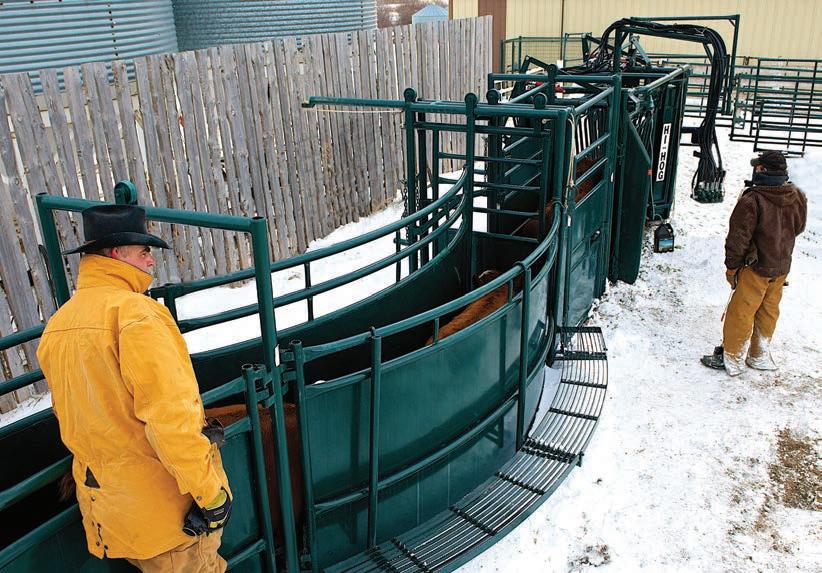
The Idaho BQA Program offers in-per son training opportunities throughout the year, conducted through trained Cer tified Trainers around the state. You will find the latest information on in-person trainings by visiting the IdahoBeefQuali ty.com website where you can select and register for upcoming events.
Currently scheduled training op tions are shown in the table below. Vis it IdahoBeefQuality.com often to learn the latest about BQA news and events in Idaho.
November 16, 202211:00 am-1:00 pm Sun Valley, ID (Immediately following the Idaho Cattle Association Convention)
December 7, 202212 noon-2:50 pm College of Southern Idaho, Twin Falls, ID
January 24, 20237:00 pm-9:30 pm Winter Beef School, Salmon, ID
April (date TBD) 5:30 pm-8:30 pm University of Idaho, Moscow, ID
Consumers, processors, retailers, and foodservice are demanding quality beef products that satisfy their desire to know that the beef industry is committed to raising and processing beef responsibly.
Each person completing BQA Certification supports Idaho’s beef industry efforts to build competitiveness and improve profitability.

BQA includes “commonsense husbandry techniques and scientific knowledge that demonstrate commitment to animal welfare, food safety and quality, safeguard the public image of beef industries, and uphold consumer confidence.” (Daniel Buskirk. Cattle Buyers to Require BQA Certification. 2018)


Nov. 16, 2022
11:00 a.m. - 1:00 p.m. Sun Valley, ID
Dec. 07, 2022
12:00 p.m. -2:50 p.m. Twin Falls, ID Jan. 24, 2023
7:00 p.m. - 9:30 p.m. Salmon, ID
Apr. 2023 (date TBD)
5:30 p.m. - 8:30 p.m. Moscow, ID
SIGN UP NOW FOR BQA CERTIFICATION TRAINING!
For more information on Idaho’s BQA Program and to register for the event, visit IdahoBeefQuality.com or call the Idaho Beef Council at 208-376-6004.
J. BENTON GLAZE, JR., PH.D. Extension Beef Cattle Specialist Department of Animal & Veterinary Science University of Idaho
Beef cattle selection is often based on producers’ instincts about the relative value of a wide range of traits including growth, fertility, reproductive efficiency, structural sound ness, carcass, calving ease and temperament. Producers should compare animals based on all the relative traits. This process of combining a number of traits into a single breeding decision is considered setting a breeding objective. Breeding objectives should be composed of all traits that affect profit (economical ly important) and some indication of the relative emphasis each trait should receive. The study cited below provides some insight as to the traits that are perceived important as producers make selection decisions.

In 2019 a survey of cow-calf producers was conducted to gath er perspectives on various management strategies and industry challenges. A total of 1,414 responses from beef producers from 44 U.S. states were included in the final study. One component of the study asked producers to prioritize the parameters (traits) used for selecting bulls and replacement females to use in their herds. The prioritization of traits when selecting bulls is present ed in Table 1 and the prioritization of traits when selecting replacement females is pre sented in Table 2. In both tables, the percent ages represent an aggregate value of when the traits were deemed either very important or extremely important. In the paragraphs below, a discussion of some of the econom ically important traits and tools to improve them is provided.

The 2017 National Animal Health Moni toring System (Beef-2017) survey indicated that dystocia was responsible for approx imately 25% of all calf losses and approxi mately 17% beef breeding cattle losses. As producers consider bulls to produce replace ment heifers or bulls to use on first-calf heif ers, they should make selection decisions that lead to a reduced incidence of dystocia.
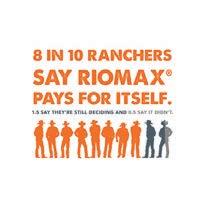
A couple of tools that producers can use in this selection process are maternal calving ease (MCE) expected progeny differences (EPDs) and calving ease (CE) EPDs.
Maternal calving ease (MCE) EPD are expressed as a differ ence in percentage of unassisted births and predict the differ ence in ease with which a sire’s daughters will calve as first-calf heifers. Larger values indicate greater calving ease (larger per centage of unassisted births) in a sire’s daughters. In a compar ison of two bulls being considered for use to produce replace ment heifers, it is noted that Bull #1 has a MCE EPD of +5.5 and Bull #2 has a MCE EPD of +13.5. This suggests that 8% more of Bull #2’s daughters would calve unassisted as first-calf heifers than Bull #1’s daughters.
Calving ease (CE) EPD are expressed as a difference in per centage of unassisted births and predict the difference in ease with which a sire’s calves will be born when he is mated to first-calf heif ers. Larger values indicate greater calving ease (larger percentage of unassisted births) in first-calf heifers. In a comparison of two bulls considered to be used on first-calf heifers, it is noted that Bull #3 has a CE EPD of +19.0 and Bull #4 has a CE EPD of +6.0. This suggests that Bull #3, when bred to first-calf heifers, would sire 13% more calves that are born unassisted than Bull #4.
Reproductive efficiency determines to a great extent the prof itability of the beef cattle enterprise. Without live calves on the
ground, there are no opportunities to measure other traits and market calves. It is clear, that reproductive traits should receive a great deal of emphasis in selection programs. While there is no single trait/measure to assist producers with improving repro ductive efficiency in their herds, following are a few examples of traits/tools that could be considered by producers as they strive to improve reproductive efficiency and longevity.
Heifer pregnancy (HP) EPD are expressed as a difference in percentage of a sire’s daughters conceiving to calve at two years of age. Larger values indicate greater numbers of pregnant heif ers. Heifer pregnancy EPD may be used to improve reproductive efficiency in a breeding herd. In a comparison of two bulls being considered for use to produce replacement heifers, it is noted that Bull #5 has a HP EPD of +3.5 and Bull #6 has a HP EPD of +9.5. This suggests that 6% more of Bull #6’s daughters would end up pregnant as two-year-olds than Bull #5’s daughters.
Scrotal circumference (SC) EPD are expressed in centimeters and represent the sire’s ability to transmit scrotal growth to his offspring compared to other sires. Larger values indicate greater scrotal circumferences. Scrotal circumference EPD may be used to improve reproduction in breeding herds through improved semen traits (males) and decreased age of puberty (males and females). In a comparison of two bulls being considered for use in a herd, it is noted that Bull #7 has a SC EPD of +0.4 and Bull
#8 has a SC EPD of +1.2. This suggests that Bull #8’s male calves would have scrotal measurements 0.8 centimeters greater than Bull #7’s male calves at a year of age.
Stayability (STAY) EPD are expressed as a difference in per centage of a sire’s daughters remaining in the breeding herd until at least six years of age. Larger values indicate greater numbers of cows remaining in the breeding herd for longer periods. Stay ability EPD may be used to improve reproductive efficiency and longevity in a breeding herd. In a comparison of two bulls being considered for use in a herd, Bull #9 has a STAY EPD of +11.0 and Bull #10 has a STAY EPD of -3.0. This suggests that 14% of Bull #9’s daughters would remain in the herd until at least six years of age compared to Bull #10’s daughters.
According to the NAHMS Beef-2017 survey, 21.1% of the cows that were removed from herds were culled due to physical un soundness. In recent years, the American Angus Association has provided claw set and foot angle EPD to assist producers in maintaining and improving the level of physical in beef cat tle herds. Claw set is scored on a 9-point scale (1 = splayed, 9 = overlapping), as is foot angle (1 = steep, 9 = shallow). In both cases, a score of 5 is ideal. The target claw set is a hoof with toes that are symmetrical and toes that are evenly and appropriately spaced. The target foot angle is characterized by a 45-degree an gle at the pastern joint and a pastern that has appropriate length and heel depth. Recently, only scores of 5 to 9 were being used in the genetic evaluation, so lower scores (EPD) are more favorable. Following are examples of a couple of tools that can be used to improve structural soundness and longevity in beef cattle herds.

Claw set (CLAW) EPD are expressed in units of claw-set scores with lower EPD being more favorable. Consider and com pare the following two bulls: Bull #11 has a CLAW EPD of +0.50 and Bull #12 has a CLAW EPD of +1.50. This suggests that Bull #11, when bred to a group of beef females, would sire calves that would be a full score closer to the target.
Foot angle (ANGLE) EPD are expressed in units of foot-an gle scores with lower EPD being more favorable. Consider and compare the following two bulls: Bull #13 has an ANGLE EPD of +1.00 and Bull #14 has an ANGLE EPD of +0.50. This suggests that Bull #14, when bred to a group of beef females, would sire calves that would be a half score closer to the target.
Today, beef producers have excellent tools to estimate the genetic worth of animals for various economically important traits, including those related to calving ease, reproduction, and structural soundness. As producers make selection deci sions, they should choose animals that have the potential to positively influence the performance for these traits in future offspring. Producers should also make sure that the selection objectives for the traits discussed here are in balance with the selection objectives of other economically important traits (e.g., growth, carcass).
University of Idaho Extension beef specialist John Hall has a prestigious new title and additional tools to serve his students and the state’s livestock indus try thanks to a gift from the family of his former boss and mentor, the late Carl Hunt.


Hall has recently been named as the inaugural recip ient of the Hunt Family Beef Education and Research Endowed Professorship. It honors Hunt, who died in September 2021 and was head of the former Depart ment of Animal and Veterinary Sciences when Hall was hired in the spring of 2008.
Hall will hold the professorship for three years before it is awarded to another faculty member. The endowment supports nutrition-based livestock research, as well as educational activities and a graduate assistantship.
“It’s a great honor and I’m very humbled to be select ed for the professorship, especially because it’s named after Dr. Carl Hunt,” Hall said. “Dr. Hunt was a tremen
dous person for CALS. He really showed a strong inter est in you as an individual faculty member and was also really dedicated to building teams and building good working groups within the department.”
Carl and Martha Hunt originally established the en dowment in 2013 with the goal of ensuring continued commitment to beef cattle education and research at U of I. For several years, the endowment supported graduate students in animal sciences focused on beef nutrition, but the Hunts’ ultimate goal was to build the endowment to $1 million, sufficient for an endowed professorship. The family met the goal last year. Additional contributors to the endowment included the Idaho Cattle Foundation, in dustry partners and friends.
According to Carl and Martha’s children, Daniel and Katherine, the family is tremendously grateful to the donors, friends, and generously committed organiza tions that contributed to the endowment.
“Dad’s decades-long vision remains our mission: to put U of I on the map as a national destination for beef science research and learning,” Katherine said. “Funding Dr. Hall’s research is a great start for making his vision reality – we are confident the training he provides and the data his work generates will provide a significant boost to the Idaho cattle industry.”
Hall’s research has focused on re productive management of beef herds and the effects of nutrition on cattle re production. Hall will use endowment funds to buy time-saving equipment, including technology to remotely mon itor cow behavior to determine which animals are in heat. He will also use the endowment to fund a multi-year graduate assistantship. The student will start work in the spring of 2023, studying how the timing and quanti ty of polyunsaturated fatty acids de livered in a form that can’t be altered within the rumen may increase cow pregnancy rates.
Furthermore, Hall will use the en dowment to cover student education al opportunities, such as sending the graduate student to livestock industry and scientific meetings and the estab lishment of a multi-day undergradu ate tour of the state’s beef industry.
“The neat thing about Idaho is we do have the breadth of the industry


contained within the state’s borders,” Hall said. “This gives our students a really good chance of having a bet ter understanding of the total beef industry in Idaho and ideas of what they might be able to do for a career in the industry.”
Hunt left a lasting mark on the department. For example, he started the longstanding Steer-A-Year program, through which ranchers donate cattle to the university. Students raise the cattle in a university feedlot, gaining livestock man agement experience, with proceeds benefiting student schol arships for the Department of Animal, Veterinary and Food Sciences and Vandal athletics.
John Hall is stationed at the Nancy M. Cummings Research, Extension and Education Center near Salmon. The ranch, made possible by a generous donation from the Auen Foundation of
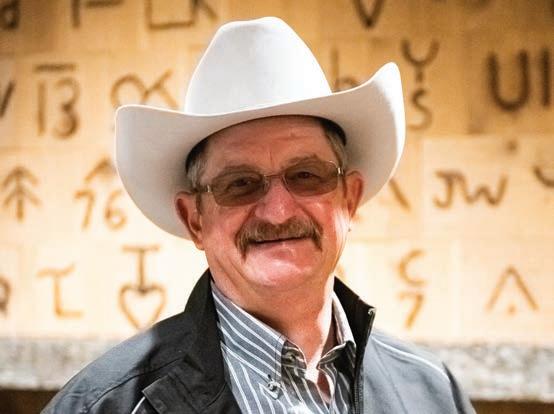






Caitlin Allison
Vitalix, Inc. BAT, LLC
Frank & Cindy Bachman
Wil Bangerter
Beaver Machine & Cattle
Gold Handle Coffee
Lee Bradshaw
Flying Triangle, Inc. Rio Hondo Piedmontese
Brown’s Land & Cattle
Liphatech Inc.
Cada Livestock Company
Desert View Ranches
Hailey Crawford
Ditto Creek Ranch LLC Erin Daniels
Darrow Farms Inc.
NEOGEN Dixon Farms
Bill & Ann Ebener
Egan Land & Cattle LLC
Lookout Land & Livestock
Blackfoot Livestock College of Southern Idaho Ag Dept.
Diamond G Ranches
Pitchstone Waters Land & Cattle
Real Tuff Cattle Equipment
Alexander Hampton Zoetis
Phil W. Heitstuman Land & Cattle
Heuett - Watson Land Co - LLC
Horseshoe A Inc.
Rex Hoagland Holmes Ranch Envu
Kayla Hurl Animal Health International Hall and Hall Ranch Brokers
Robert Jones Realty, Inc.

Kunafin “The Insectary”
Kerner Cattle Co. TLC Angus Lequerica and Sons Gateway Realty Advisors

Montana MacConnell Martiny Ranch
Meeks Ranch LLC
Allison Creek Ranch
Mink Land & Livestock
Endovac Animal Health
Vonni Mulrony
Dave & Diane Myklegard
Sterling Marketing Inc.
V Dot Cattle Company Kem Palmer LLC
Laird Manufacturing Pestarino Ranch
John Peters Miles Peters
Peterson Law Office PLLC
Dean Pike
R&M Steel Co. Mountain K Ranch
JR Tree Custom Spraying
John & Amy Ruhs Margaret Shaw Elizabeth Shaw Sid Showell
Premier Livestock Consulting, LLC
MWI Animal Health/ MICRO Technologies Dutch Flat Angus LLC
Ward Ranch Inc
Dan & Kalena Webb Shalani Wilcox
Eric & Tori Wittman Hulme Ranch
Timber Creek Recycling Datamars Inc.


